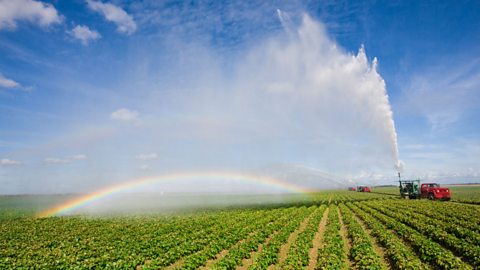What are enzymes?
Enzymes are proteins that act as biological catalysts.
They speed up the rate of reactions without being used up.
Enzyme action
Each enzyme has an active site, which is where the reaction takes place.
The lock and key model explains how enzymes work:
The enzyme is like a "lock".
The substrate (the molecule it reacts with) is like a "key" that fits into the lock.
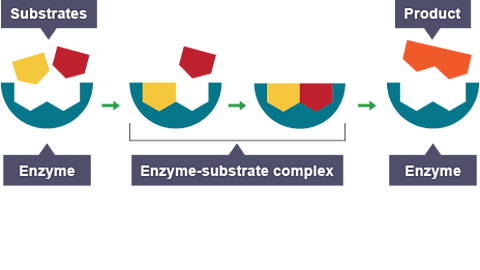
Key facts about enzymes:
an enzyme’s active site and its substrate are complementary in shape
enzymes and substrates collide to form enzyme-substrate complexes
the substrates are broken down or built up quickly
the products are released
the enzyme can be used over again
Enzyme specifity
Each enzyme is specific and acts on only one substrate to catalyse one reaction.
The active site has a specific shape that is complementary to the shape of its substrate, allowing them to fit together like a lock and key, meaning each enzyme works with only one specific substrate.
Inhibitors
Inhibitors are molecules that fit into an enzyme’s active site but are not broken down.
They stop the substrate from fitting into the action and prevent enzyme-substrate complexes forming so reduce the rate of reaction.
How does temperature affect enzyme activity?
As temperature increases the rate of enzyme activity increases, up to the optimumThe temperature, pH or enzyme concentration that allows the enzyme to work at its best. temperature, as more kinetic energyEnergy which an object possesses by being in motion. causes more collisions between the enzyme and substrateA substance on which enzymes act. forming more enzyme-substrate complexes.
Above the optimum temperature the enzyme’s active site becomes denaturedWhen an enzyme’s active site loses its shape meaning it can no longer work..
This means the active siteRegion of an enzyme where the substrate attaches. changes shape and can no longer form enzyme-substrate complexes, leading to a decrease in enzyme activity.
Denaturation is a permanent change.
How does pH affect enzyme activity?
pH
Deviating from the optimum pHScale of acidity or alkalinity. A pH (power of hydrogen) value below 7 is acidic, a pH value above 7 is alkaline. (too high or too low) causes the enzyme’s active site to become denatured and the active site changes shape.
It can no longer form enzyme-substrate complexes, leading to a decrease in enzyme activity.
Watch: A BBC Teach clip investigating the effect of pH on enzyme activity
Enzyme concentration
As the enzyme concentration increases, the rate of enzyme activity increases because there are more enzymes to form enzyme-substrate complexes.
This happens up to a certain point. Enzyme activity then levels off (plateaus) as there are not enough substrate molecules to react with the extra enzymes.
Optimum
The optimumThe temperature, pH or enzyme concentration that allows the enzyme to work at its best. value is the level at which the reaction rate is at its maximum, ie, fastest.
Practical 1.4 - Effect of temperature on the action of an enzyme
Procedure:
Add 20ml of hydrogen peroxide (H₂O₂) to each test tube
Place each test tube in a water bath set at different temperatures (eg 10°C, 20°C, 30°C, 40°C, 50°C)
Add 2g of raw potato (which contains catalase enzyme) to each test tube
Measure the volume of oxygen gas produced using a gas syringe for 1 minute
Record results
Results
| Temperature / °C | Volume of oxygen gas produced / ml |
|---|---|
| 10 | 5 |
| 20 | 10 |
| 30 | 25 |
| 40 | 35 |
| 50 | 0 |
Conclusion
As the temperature increases, the rate of enzyme activity increases, up to 40°C, which is the optimum temperature for the enzyme.
Beyond 40°C, the enzyme becomes denatured.
Independent variable: temperature / °C
Dependent variable: volume of oxygen gas produced / ml
Control variables:
- same volume and concentration of hydrogen peroxide
- same mass of potato (enzyme)
- collect gas for same time
What role do enzymes play in the digestive system?
Enzymes are used in the digestive systemOrgan system involved in breaking food down so that it can be absorbed into the bloodstream. to break large, complex, insoluble food molecules into small, simple, soluble molecules so they can be absorbed into the bloodstream.
| Enzyme | Substrate | Product |
|---|---|---|
| Carbohydrase or Amylase | Starch | Simple sugar, glucose |
| Protease | Protein | Amino acid |
| Lipase | Fat (lipid) | Glycerol and fatty acids |
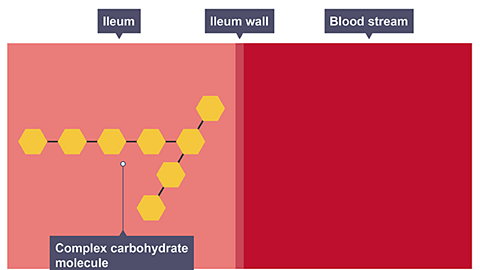
Image caption, Molecular breakdown
A large, insoluble food molecule enters the ileum.
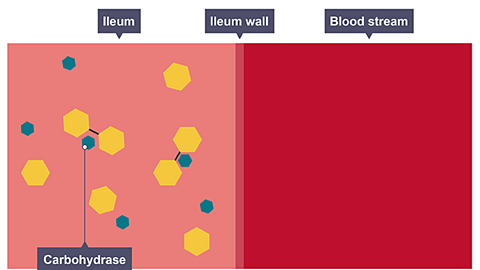
Image caption, Molecular breakdown
The complex food molecule is broken down by the enzyme.
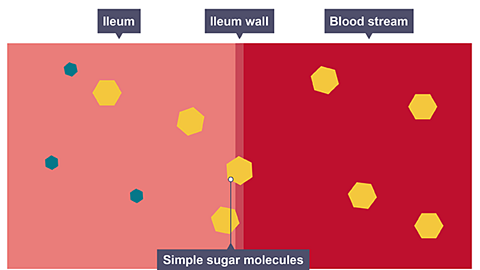
Image caption, Molecular breakdown
The simple food molecule enters the bloodstream through the ileum wall.
1 of 3
The small intestine (ileum)
Most food is digested in the ileum by enzymes. Its main function is to absorb digested food into the bloodstream for transport to body cells.
Adaptation of the ileum for absorption:
- large surface area – due to being long and folded
- thin – digested food doesn’t have to travel far to reach the blood
- permeable – digested food can pass through easily
- good blood supply – to maintain the concentration gradientThe difference in concentration between two solutions, between different cells or between cells and a surrounding solution. for diffusionThe random movement of a substance from a region of high concentration to a region of low concentration. between the ileum and bloodstream
- villi – finger like projections that further increase surface area
Features of the villi that aid absorption:
- good blood supply – a villus has a large network of capillariesSmall, permeable blood vessels present in the organs of the body that allow the diffusion of substances like oxygen and glucose.. Once blood becomes high in digested food products it is transported away and replaced with blood that is low in digested food products. This maintains the concentration gradient necessary for diffusion between the ileum and bloodstream.
- lacteal – a tube that absorbs the products of fat digestion before returning them to the blood
- single layer of surface epitheliumType of tissue that lines or covers surfaces of an organism. It is made up of epithelial cells. cells – this reduces the diffusion distance that digested food products have to travel in order to enter the bloodstream
- permeable – digested food can pass through easily
What are the commercial and economic uses of enzymes?
Enzymes are used in biological washing powders to break down stains.
- Protease breaks down proteins (eg blood, egg stains).
- Lipase breaks down fats and oils (eg grease stains).
- Amylase breaks down starches (eg food stains).
Advantages:
- work quickly at lower temperatures, saving energy and money
Disadvantages:
- enzymes are denatured at temperatures above 40°C
- some people may be allergic to enzymes, leading to skin irritation
How much do you know about enzymes?
Digestive system activity
Play this game to explore how food is processed by the human body.
More on Living processes
Find out more by working through a topic
- count5 of 6

- count6 of 6
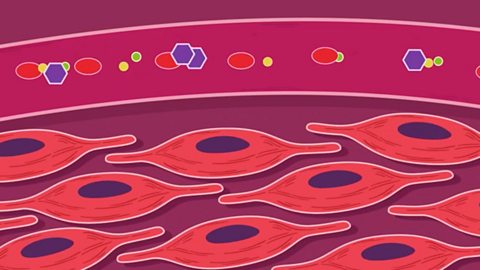
- count1 of 6
